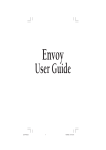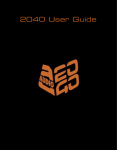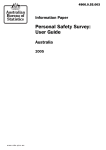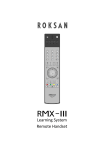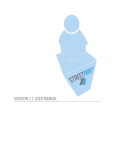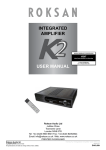Download Audio Envoy
Transcript
INSIDE TRACK Audio Envoy SIMON JONES MIBS gets to grips with some ingenious and colourful British-built remote controlled radio microphone systems. TX Blue he most obvious and distinctive feature of Audio Ltd’s new Envoy range of radio microphones and transmitters is the colour – a move away from the traditional black exterior to a beautiful metallic bluish-purple. Sadly on the receiver at least – the CXiR – this will often be completely hidden because the Envoy range is designed primarily for use in Electronic News Gathering (ENG) applications with DVC-Pro, DVCam and Beta-SX camcorder formats which incorporate slots for radio mic receivers. T TX Blue SwitchiR The Envoy range begins with the transmitter, coded Tx Blue which, other than the cosmetics, is little different from the RMS2020 transmitter. The sleek pocket-sized unit has a slide-out compartment in the base to house a single 9V PP3 battery, which will provide power for at least six hours. Removing the battery drawer gives access to the operating frequency selector, a small rotary switch which allows the user access to sixteen settings, but combined with a front panel ‘bank switch’, the unit can operate on 32 different frequencies. A small screwdriver and a torch you can hold in your teeth are required tools! At the business end of the unit three switches activate a high-pass filter, select between the two banks of operating frequencies, and switch the unit on or off. However, this last is redundant for most users as the Lemo microphone connector contains a power circuit link which turns the unit off when unplugged. A rotary gain control switch provides up to 30dB in seven steps, while positions 8 and 9 accommodate line level inputs. An overload indicator is provided which also flashed when the TX Blue is first turned on to indicate life in the battery. The unit emits 50 milliWatts of radio-frequency power – the maximum permitted for this type of product in Europe – through its antenna, which is connected via a threaded SMA type connector. HXiR For a number of years, Audio Ltd have been promising an improved handheld radio microphone, and it arrived in advance of the rest of the Envoy range, called the HXiR. As with its 32 LINE UP Aug/Sept 2002 predecessor, the HX2020, Audio have employed a Schoeps Colette microphone capsule which can easily be swapped out for any of the 18 varieties in the range! A foam windshield is available if the integral mesh proves insufficient, but the resistance to wind and handling noise is much improved compared to the earlier HX2020 model, thanks in no small part to the involvement of Rycote. Just below the windshield sits an interchangeable coloured ring, and the battery compartment can also be fitted with coloured bungs – the two affording 36 different colour combinations! The body of the radio-mic tapers gently from a maximum diameter of 35mm at the base of the windshield to 18mm at the opposite end. In the middle is a strange rectangular window and a small black button to switch the unit on, while just below this is the battery compartment. Pulling the end section reveals an AA-size compartment and a lithium battery provides up to seven hours operation. The battery compartment also encapsulates the antenna and a ring around the top of the compartment illuminates when the On button is pressed. Once on, the radio-mic cannot be accidentally turned off without disconnecting the battery momentarily (simply pulling the battery back against the spring to break the circuit is sufficient). SwitchiR The thing I haven’t yet mentioned about the HXiR connector for the purpose. Audio Ltd have overcome this by producing a variety of adapter ‘shoes’ to interface the receiver with the camera system. A shoe is also available with a single 6-pin Lemo connector that is compatible with the company’s older units and their connecting cables, allowing the Envoy receiver to be used independently. Ironically, this shoe has outsold all others to date. The CXiR has no battery compartment, relying on external power normally fed via the camera slot in which it is installed, and it is therefore somewhat shorter than an RMS2020 receiver. The top of the unit contains all the useful items: two SMA connectors for the diversity antennae, the infrared port, and four status LEDs. These have the same functions as those on the DX2020: an amber light warning of a low battery level in the transmitter, a red ‘no signal’ warning, and two yellow LEDs (on the outside edges) indicating which antennae is in use at any moment. Handy Display AudiR PC Control Software is what the iR bit is actually all about, and the answer is infrared remote control – both of the transmitter and compatible receivers. The SwitchiR – a little unit the size of a car alarm remote – is the key to the innovation in the Envoy range. It features just a seven-character LCD and four buttons: Menu, OK, Up and Down. Nevertheless, this simple device provides a pretty intuitive means to control a range of functions on any number of Envoy transmitters and receivers. The Menu button cycles through a list of functions, and the Up/Down keys scroll through the various options. These are mainly self-explanatory such as Frequency; Audio level setting (confusingly labelled ‘AF’); high-pass filter; Battery level of the relevant Envoy unit; and Internal Battery level of the SwitchiR itself. A pair of contacts on the side of the control allowing testing of a PP3 or equivalent battery via another menu function, and the Serial Number and User ID of Envoy equipment can also be interrogated. The remote control facility can also be deactivated if required, although it is automatically reactivated when the unit is powered off and on again. There are a couple of drawbacks to the infrared control: line of sight is needed between the remote and the unit to be controlled, and the angle of acceptance is quite small. The working range is up to a metre – but in strong daylight the range may be reduced by up to 75%. However, the system is very immediate – there are no control cables to connect and no fiddly screwdrivers to poke into dark holes. Receivers There are two receivers in the Envoy range, the Diversity CXiR and the non-diversity MXiR – the former was supplied for review. As mentioned earlier, the Envoy receivers are designed to slot into suitable ENG camcorders, but each camera manufacturer employs a different multipin 34 LINE UP Aug/Sept 2002 As if the SwitchiR isn’t clever enough in itself, Audio Ltd have taken the infrared possibilities a stage further by providing remote control software, AudiR, to operate on any palmtop computer running Palm OS – such as the Palm Pilot and HandSpring range – or a PC. The advantage is that the much larger screen available on these systems allow many of the SwitchiR’s features and control status to be viewed simultaneously. Having launched the software, a blank Status screen is displayed. The infrared port on the palmtop (or whatever platform is being used) is aligned with that on any Envoy iR product, and the ‘Get Data’ button on the screen is clicked to download the unit’s model type, serial number, battery status, active frequency and corresponding channel number, and PLL status (which assures the user that the output frequency is locked on the correct setting, and has not drifted). If the scanned device is a transmitter, it will also indicate the microphone gain and whether the high-pass filter is active; a receiver will display the battery status of the transmitter it is tuned to, along with squelch status, RF signal strength, and any output attenuation. There are two further screens. The first is the Frequency selector, showing the frequency programmed to each channel. Clicking on a different channel, followed by the ‘Update’ button will change the operating frequency of the device. The second screen is the Edit page, which allows the device’s parameters to be altered and the new configuration passed back (as long as the IR ports are still aligned, of course), by pressing the ‘Update’ button. The ‘User ID’ parameter can also be changed, using up to 16 characters, although only simple numeric IDs can be displayed on the Envoy units due to the limitations of their seven-segment displays. The AudiR software has six menu pages in total, but not all are of practical use to the recordist – the ‘Device Info’ page, for example, provides information about the model type, firmware version, and the Type approval. However the two screens used exclusively in conjunction with the MXiR or CXiR receivers are the real gems in this software. The ‘Plot’ page provides a continuous graph of signal strength at each antenna, giving a real indication of just how well the system is working. I tried this while filming at the transporter bridge in Middlesborough, noting a reading of around -50dBm as the presenter loitered by the crew. As he moved into position for his piece to camera, 50 yards away on the all-metal bridge of the transporter cradle, the graph showed the dramatic loss of signal, down to around -80dBm. This was still strong enough to give quality reception, though, and to hear every gust of wind as it rang through the structure of the bridge! The last, and potentially most useful page to the location recordist is the ‘Scan’ window. Once activated, the receiver tunes to each of its thirtytwo channels in turn, and the strength of any signals found is plotted on the screen. This is extremely useful for finding out which channels are free in the area, and the transmitters and receivers can then be tuned accordingly – a very useful feature which brought a smile from every sound recordist who saw the system during my time with it. However, this facility also draws my strongest criticism. If a transmitter is in use a strong signal will register on the appropriate channel, but a number of other bands may also show strong signals, apparently spaced randomly. A little study suggests that what is being seen is another channel very close in frequency, due to the way frequencies are mapped to channels by the system design. This is the beginning of a very useful system – it can certainly show which channels to avoid. However, as a group of recordists found recently during a multi-camera shoot at G-Mex in Manchester, it doesn’t help with the problem of co-channel interference – the channel spacing is critical. What would be more useful, therefore, is if the AudiR software could analyse the scan results and suggest suitable transmission channels which could be used safely with the frequencies already in use. After all, radio-mic manufacturers already have tables of compatible frequencies and, as Kishore Patel, MD of Audio Ltd explained to me, “There are 14 UK channel Ch69 frequencies, of which six work very well together, without any third order intermodulation effects. We tend to programme the frequencies in our systems in groups, whereby the frequencies within each group are compatible with each other.” A nugget of information which I hadn’t heard before. Altogether it is pretty impressive stuff and although I don’t think I would routinely use the AudiR software on location, if I was up against poor reception it would certainly become very useful to identify whether the poor performance was due to AudiR Plot Page AudiR Scan Window interference from another transmitter, or a problem with my own equipment. No Compromises At £1200, the CXiR is just over 20% cheaper than the equivalent DX2020, yet incorporates the new infrared controller technology so what has been compromised in the design? Kishore explained that because the Envoy receivers are designed primarily for use with digital camcorders some compromises have had to be made to accommodate the size requirements. However, these are really only the absence of an internal battery and no multiway connector for racking – the CXiR receiver is not designed to be used in a multichannel situation, whereas the DX2020 is. There are no compromises at all in the audio performance, or in the usable range. In the search for quieter spectrum, recordists wanting one or more radio mics on VHF channels may disappointed, at least for the time-being; “We have received a number of requests for the Envoy system on the VHF band,” Kishore told me, “and we are currently investigating the possibility. There are only a few markets left in the world which require radio mic systems to operate in the VHF band, the UK being one of them.” With more single-person crews these days, Audio Ltd should do well with the Envoy range in the ENG market. However, the opportunities afforded by the infrared technology also have great potential and I’m sure most sound recordists will look on the Envoy with envy. Audio Ltd Tel: +44 (0)1494 511 711 www.audioltd.com LINE UP Aug/Sept 2002 35



